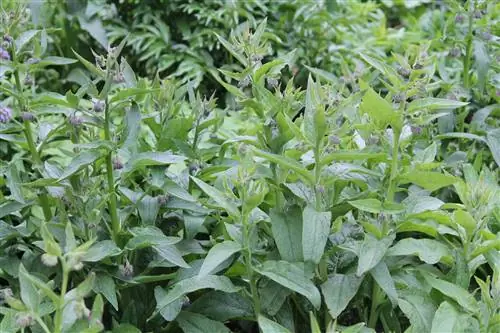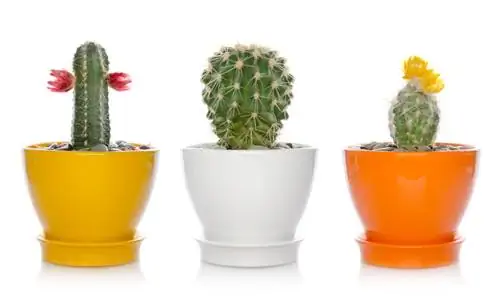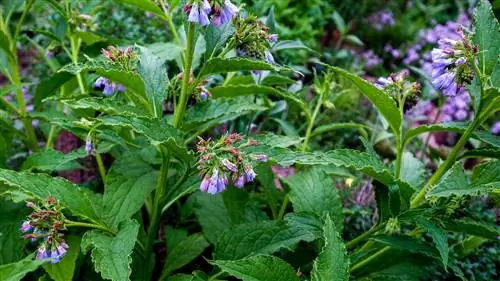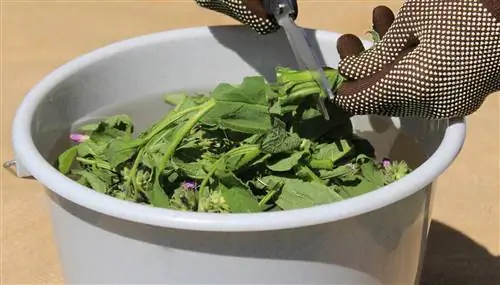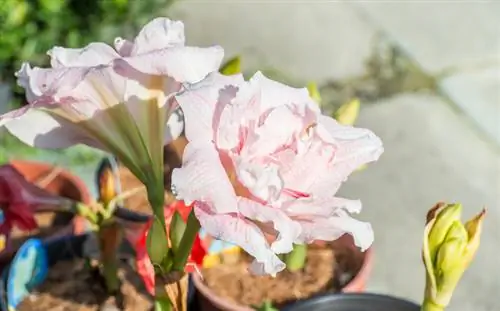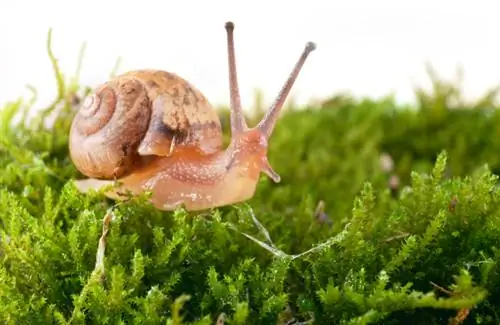- Author admin [email protected].
- Public 2023-12-16 16:46.
- Last modified 2025-01-23 11:19.
Comfrey is known as a medicinal plant for broken bones, bruises, etc., but it is a thorn in the side of many a gardener. Once established, this perennial is not so easy to get rid of. Read below to find out how it works.

How can you combat comfrey?
Comfrey is effectively and long-term controlled by cutting off itsflowersbefore seed formationand itsrootscompletelyexcavated and destroyed. Otherwise, the plant spreads through self-sowing and individual root parts could sprout again underground.
Why is it difficult to get rid of comfrey?
Once established in the location, comfrey is difficult to remove due to its persistent anddeep roots. The plant also makes control more difficult due to its rapid seed production andSelf-sowing From May onwards, its flowers appear, and the seeds that develop later like to sow themselves. Last but not least, the plant has no natural enemies as it is completely uninteresting even for grazing animals. This is because the parts of the plant are not particularly tasty due to the alkaloids (pyrrolizidine alkaloids) they contain, but are poisonous.
When should comfrey be controlled?
It is best to combat comfreybefore orat the latestduring flowering. Then he has no opportunity to grow his seeds and distribute them in the area.
Why does comfrey quickly become a pest in the garden?
Comfrey can make life difficult for a gardener because, on the one hand, it reproduces independently usingSelf-seedingand also uses itsunderground rhizomesfor its distribution uses. On the other hand, Symphytum is perennial, frost-hardy and almostindestructible This plant survives even without care and in dry conditions.
Is it recommended to combat comfrey?
Fighting comfrey ishardly recommended, as this plant is not only a well-known medicinal plant, but is also very popular with bees, bumblebees and butterflies. If possible, comfrey should therefore be allowed to exist in the garden and only be controlled when necessary or if it spreads widely.
How can comfrey be controlled without chemicals?
In order to get rid of comfrey in the long term, its entireroot system should be dug up. Even the smallest root parts should not be left in the ground as they could sprout again. In the worst case scenario, you will have to dig more than 1 m deep to be able to grab and remove all the roots. If you just want to limit the spread of comfrey, you should cut the plant before it blooms.
Tip
Do not throw away plant parts of comfrey, but use them
You can use the removed leaves and stems of this rough-leaf plant for a fertilizer mixture. A manure made from comfrey is quick to make: Simply mix the previously chopped plant parts with plenty of water, let stand for a few weeks, strain and add the broth to the irrigation water.

